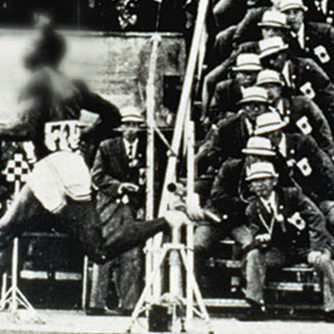This is the second part of a three-part feature taking a closer look at the stopwatch and the chronograph.
In Part 2, we unravel the evolutionary history of the functionality and accuracy of chronographs, from the time that a stopwatch function was first added to a watch in 1877.
History of the Chronograph
While the idea for a chronograph incorporating stopwatch functionality (for measuring the passage of time) into everyday portable watches had existed since the creation of the first stopwatch, there were significant technological obstacles to overcome.
In the case of a stopwatch, it is simply enough to begin transferring the power of the unravelling spring to the cogwheels when the watch is started. In the case of a chronograph, however, it is necessary to transfer mechanical driving power from the continuously moving “clock” part of the watch to drive the stopwatch function while measuring the passage of time, and then sever the supply of energy when measurement has finished.
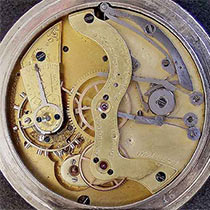
With the car races that began at the end of the 19th century and the creation of the first airplane at the beginning of the 20th century—and later, with the outbreak of the two world wars—the whole world began to feel the necessity for chronographs. This spurred an acceleration in the pace of their development by the various watch manufacturers.
In 1876, the Swiss watchmaker Henry Alfred Lugrin* found a solution to the problem of power transfer, and conceived the design for the world’s first pocket chronograph. In terms of a commercial product, it is thought that the watch launched by the American Watch Company (Waltham) in 1877 was the first (see photograph).
Almost immediately after this, the Swiss watch companies Timing and Repeating Watch Company (Geneva) and Longines also produced commercial watch designs of their own.
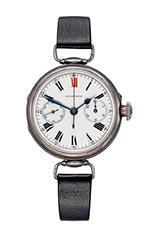
The next step was the invention of a split-time function, and mechanism for measuring the performance times of multiple competitors. Breitling achieved the realization of this functionality with the development of its “split-second” design in 1889. This watch—also called the Rattrapante—had two central second hands, aligned perfectly, one on top of the other. When the split-second button is pressed, one of the second hands stops, while the other continues to move as normal.
When the button is pressed once more, the stopped second hand instantaneously catches up with the moving hand, and continues to measure time normally.
Until this time, chronographs had been pocket watches, requiring the effort of taking the watch out every time one wanted to use it. Some people who needed to check the time frequently, such as racing drivers and pilots, even began to lash their pocket watches to their arms themselves. It became clear that a wristwatch-type chronograph design was needed.
In 1913, Longines solved this issue by creating the first wristwatch-type chronograph. (see photograph)
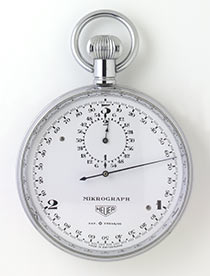
This was followed by a product that dramatically reduced the size of the smallest unit of time that could be measured (see photograph).
The 1916 Heuer Mikrograph was a stopwatch with a movement that oscillated 100 times every second, enabling measurements to 1/100 of a second. (Although this was a stopwatch, not a chronograph.)
The evolution of chronographs continued.
The evolution of chronographs continued.
In 1923, Breitling developed its “flyback” chronograph. This design had a mechanism that enabled the timer to be reset without stopping the current measurement and immediately begin the next measurement.
In 1929, Longines achieved the creation of a split-second wristwatch.
From the 1910s into the 1930s, companies like Heuer and Zenith developed several chronograph designs that were embedded in the dashboards of cars and aircraft.
In 1934, developed a chronograph design that divided the start/stop and reset functions between two separate buttons; a mechanism intended to prevent mistakes during hectic time measurements. Today this seems trivial, but the level of airtightness in watch case designs at the time was poor, and ensuring moisture-proof and dust-proof performance with three holes in the case (including the winding knob) was a difficult feat to achieve.
Around this time, watches began to emerge that made use of not only the actual watch itself, but also the additional functionality of the bezel surrounding the dial face. A tachymeter is used to calculate speed based on distance and time. By inscribing numbers onto the watch bezel, it became easy for users to know their speed of travel. Manufacturers like Longines and Breitling incorporated circular slide rules to enable aviators to calculate such things as flight times and remaining fuel.
During World War II, Rolex developed an antimagnetic chronograph that was less susceptible to being affected to magnetism onboard aircraft.
Mechanical Chronograph Mechanisms
Mechanical chronographs use a mechanism whereby the constantly moving clock mechanism and stopwatch mechanism are connected mechanically in order to provide mechanical power needed to drive the stopwatch element.
The mechanism used to achieve and sever this connection is called a clutch (or coupling), similar to the clutch found in a car. Clutch mechanisms are divided chiefly into two categories: horizontal clutches and vertical clutches. Horizontal clutch mechanisms are divided further into carrying arm mechanisms and swing/oscillating pinion mechanisms.
Horizontal clutches work by moving a cogwheel (called a transmission wheel), which is constantly rotating under the power of the watch mechanism, and interlocking it with another cogwheel on the chronograph-side (called the chronograph runner).
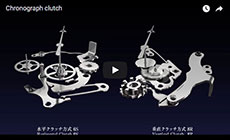
In a vertical clutch mechanism, the cogwheels in the clock and chronograph parts of the watch are positioned vertically above and below one another on the same axles.
In a normal state, levers from both sides come between the two sides, keeping them separated. When the start button is pressed, the levers separate horizontally to the left and right. The force of a spring pushing up lower the cog wheels lifts it up, bringing it into direct contact with the upper cog wheels and causing the wheels to rotate together.
As far as mechanisms for switching between start, stop and reset states, there are essentially two types: pillar / column wheel mechanisms and cam-type mechanisms.
From the time of the appearance of the first chronograph until the 1920s, chronographs were niche products that served a special purpose. Later, however, they came to achieve popularity as products that symbolized high precision and engineering capabilities.
This increase in popularity can be appreciated by examining the export statistics for Switzerland, which at the time made the majority of the world‘s clocks and watches. In 1930, only around 100,000 chronographs were exported: a mere 1% of total exports. By 1950, though, this figure had grown to 1.4 million, or 8.4%. By 1959, chronograph exports had grown to 3.2 million, accounting for 12.4% of all exports.
Chronographs now boasted a high level of popularity. The next development goal was to develop a self-winding design.
The self-winding movement developed in 1920 offered the convenience of non-stop operation without the need for manual winding, with a spring that wound itself automatically simply by the user wearing the watch on his or her wrist. By the 1960s, this had become the standard for mechanical watches.
The now popular chronograph, however, remained limited to manually-wound designs, which lead to a gradual decline in sales. People began to choose the convenience and technological advancement of self-winding watches over manually-wound chronographs.
Due to problems with the winding efficiency and size of self-winding elements, development advanced at a slow pace. Then all at once, in 1969, three manufacturers succeeded in developing self-winding chronographs.
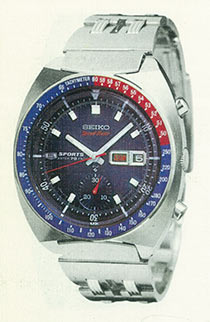
Seiko was the first company in the world to produce a commercial self-winding chronograph with a vertical clutch system and a column wheel.
It was eventually released in May of that year. This model—the 6139 Speed Timer—was a full-blown chronograph with day and date function.
Zenith also announced a self-winding chronograph—the El Primero—during the same year. The distinctive feature of this watch was its high frequency of oscillation (10 times per second). To this day, chronograph products that are capable of measuring to 1/10 of a second are symbolic of the Zenith brand.
The other watch that year was produced as the result of a joint development project involving Heuer, Breitling and Hamilton. It was announced in March. The so-called Chronomatic movement combined a manually-wound chronograph with micro-rotor technology, and adopted a unique construction in which the rotating weight was on the dial face side; the opposite of most conventional designs. While the majority of rotating weights are made almost the same diameter as the movement itself (in order to create the required amount of torque), the diameter of the micro-rotor was small. This gave the advantage of enabling the overall thickness of the movement to be reduced to fit into a thinner space.
And so the various watch manufactures had all worked to develop self-winding chronographs. However, they were gradually being forgotten as a thing of the past. At the end of that same year, Seiko announced the world’s first quartz watch, and mechanical watches in general went on to become outdated and old-fashioned.
Later, chronographs—with their image of symbolizing precision and engineering quality—were developed in the quartz world too.
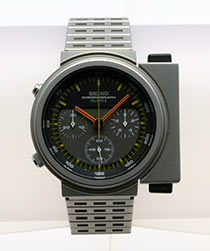
In 1975, Seiko launched the world’s first digital chronograph.
Displaying times to 1/10 of a second on liquid crystal displays (LCDs)—with their slow speed of response—proved to be a significant hurdle.
In 1983, again, Seiko launched an analog quartz chronograph (see photograph). Unlike mechanical chronographs, this watch powered the stopwatch function using a separate motor that was independent of the main clock part of the watch. The increase in electrical power consumption that resulted from the need to power multiple motors proved to be an issue during the development. The bold design by world-class designer Giorgetto Giugiaro also attracted significant attention.
After this, too, Seiko continued to develop a stream of other designs; including a 1/100 analog chronograph in 1992, a self-winding electricity-generating Kinetic chronograph in 1998, and a Spring Drive chronograph in 2007.
This spring-powered stopwatch mechanism did not use a motor as with quartz-type designs, and instead adopted Seiko’s traditional vertical clutch and pillar wheel type mechanism. Unlike quartz or mechanical chronograph models, the hands of this watch move smoothly (rather than in steps), enabling accurate measurement of the passage of time at the exact instant that the watch is stopped.
In the latter half of the 1980s, the appeal and attraction of mechanical watches once again became the focus of attention, and a stream of Swiss watchmakers began to make their comeback.
Amongst them, manufacturers such as Rolex, Omega, Longines, TAG Heuer (formerly Heuer) and Zenith all began to release chronographs, and chronographs once again became the central focus of their product lineups.
The average price of Swiss watches began to rise, and as they gradually decreased in number, chronographs alone continued to show growth. In 1990, the number of chronographs exported was less than 1 million, accounting for only 3.3% of all Swiss watch exports overall. By 2000, this figure had risen to 4.2 million (14.2%), and by 2010 the number of chronographs had reached 5.3 million, accounting for 20.1% of all Swiss watch exports.
In light of this popularity, the various watchmakers eagerly launched a stream of new products, resulting in an even greater increase in popularity.
Below are some examples:
In 2010, Zenith released the El Primero Striking 10th, with a central 1/10 second hand that travelled once around the dial face every ten seconds.
In 2011, TAG Heuer released the first ever mechanical chronograph TAG Heuer Carrera Mikrograph, which was accurate to 1/100 of a second. In 2012, TAG Heuer astonished the world with the announcement of its Mikrogirder technology, capable of measuring to 5/10,000 of a second.
After various movement manufacturers were absorbed into the Swatch Group, some firms like Rolex and IWC also began to develop their own proprietary chronograph movements.
Chronographs originally appeared as practical, functional products for accurately measuring the passage of time. Today, people see value in the complexity of their stopwatch mechanisms, the fun of their mechanical gimmickry, and their intricate beauty, and they have now developed into core luxury products.
*Henry Alfred Lugrin was born in Switzerland in 1848, and went to the United States at the age of 20. He went to work for a company called Wittnauer, where he was involved in the development of watch movements. He should not be confused with the Alfred Lugrin who founded the movement manufacturing company Lemania (born in 1858) .
References
・Begin Chronograph (separate booklet) (Sekai Bunka Publishing Inc.)
・Watches of the World No.87, published June 20, 2007 (World Photo Press Co., Ltd.)
・Post-war History of Seiko Clocks & Watches (in-house reference materials)
・History of the Product Development of Seiko Watches (in-house reference materials)
・Watch Around magazine, Issue 016 (2013) “Swiss Chronograph Industry” by P-Y Donze
・Tokei Zanmai watch and clock site
・Faszination Chronographen «Lugrin, Henry Alfred
・aBlogtoWatch watch and clock site “Why monopusher chronographs are primitive.” (8/12/2015)
・“Top 10 Technically Important Mechanical Wrist Watches” (6/29/2013)


